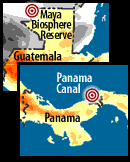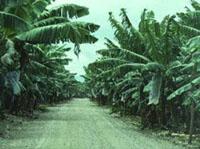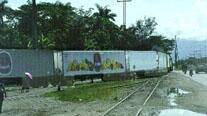|








|
 |
Pick a Region:.
. Central America

Poverty
Central America is considered to be part of the developing
world. In general, people that live in the developing world tend
to be poor, have shorter life spans, have higher rates of illiteracy,
and lack quality health care.
Within the six countries of
Central America, there is significant economic diversity. For instance,
Nicaragua is considered to be the least developed of the six countries
because it has the worst indicators (see chart below) of the Central
American countries for infant mortality rate,
adult literacy rate,
and GDP.
Comparisons of
Central America and the United States on Key Indicators*

*Sources:
United Nations Development Programme. 1999. Human Development Report
1999. New York: Oxford University Press and United Nations Development
Programme. 1997. Human development Report 1997. New York: Oxford University
Press. This table uses 1997 statistics, with exception of the Adult
Literacy Rate for the United States (which uses 1995 statistics).
In contrast to Nicaragua, Panama and
Costa Rica are more developed. With respect to GDP per capita, Panama has the highest ($3,080). However, Costa
Rica is considered to be the most "developed" of the Central American countries because
it has a relatively high GDP per capita and has the best indicators of the Central
American countries for life expectancy at birth, infant mortality rate, and adult literacy
rate.
It is
widely believed that Costa Rica’s economy has been relatively successful because when
the Spanish arrived, there was not a large indigenous population. Therefore, a two-tier
society, with the Spaniards on top and the indigenous population on the bottom, did not
evolve as it did in Guatemala, El Salvador, Honduras, and Nicaragua. Instead, its
population was primarily made up of Spaniards.
There are not only economic differences
between countries, but also within countries. For example, each of the Central American
countries has a small group of very rich individuals and a large group of very poor
individuals.
 Trade Trade
Historically, Central American trade has been very dependent on two
products: coffee and bananas. During much of this century, coffee
has been the single largest Central American export. Likewise, bananas
have been a very important export for Honduras, Panama, and Costa
Rica. Due to the importance of bananas and the fact that these countries
are republics, these three countries
have often been called "banana republics." Photo:
Banana trees in Central America. Photo by Michael Snarr.
 Most
of these exports went to the United States, which created a strong
trade link between the United States and Central America. In fact,
during the 20th century, the United States has been the main purchaser
of Central American products. In addition, most of the products that
Central America purchases come from the United States. This relationship,
however, is not as important to the United States as it is to Central
America since the goods the United States sells to and purchases from
Central America are only a small amount of total U.S. trade. Photo:
Exporting goods from Central America to the United States. Photo by
Michael Snarr. Most
of these exports went to the United States, which created a strong
trade link between the United States and Central America. In fact,
during the 20th century, the United States has been the main purchaser
of Central American products. In addition, most of the products that
Central America purchases come from the United States. This relationship,
however, is not as important to the United States as it is to Central
America since the goods the United States sells to and purchases from
Central America are only a small amount of total U.S. trade. Photo:
Exporting goods from Central America to the United States. Photo by
Michael Snarr.
In recent decades, Central America has had
success in diversifying its exports (so that it is less dependent on bananas and coffee)
and diversifying its trading partners (so that it is less dependent on the United States
as a trading partner). Nevertheless, this poor region is struggling to develop its
economy.
The Central American Common Market
In 1960 Guatemala, Honduras, El Salvador, and Nicaragua created the
Central American Common Market (CACM) in an effort to promote economic
development (Costa Rica joined in 1963). The CACM, however, has suffered
from political disagreements between El Salvador and Honduras. In
1969 political tensions resulted in a war between these two countries,
which slowed economic cooperation in all of Central America. In recent
years, efforts have been made to increase economic
integration among the six countries. One of the obstacles, however,
has been wealthy Costa Rica’s reluctance to tie its economy to
its poorer neighbors.
|
 |



    
|

